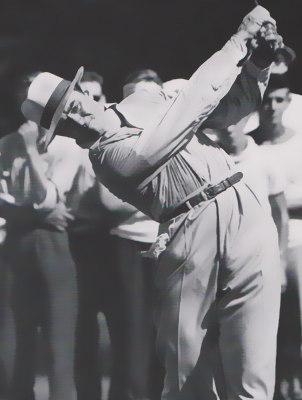What Was So Special About Sam Snead’s Setup and Swing?
 In this second article of a four-part series, John Anselmo, Tiger’s former teacher, answers the above question, as he told me when we collaborated on the book A-Game Golf.
In this second article of a four-part series, John Anselmo, Tiger’s former teacher, answers the above question, as he told me when we collaborated on the book A-Game Golf.
In the late 1940’s Anselmo turned professional and started playing the circuit with such players as Sam Snead. Snead became Anselmo’s idol and Anselmo still thinks Snead possessed the all-time model-swing. Anselmo is so strong in his opinion that when teaching Tiger, from the age of 10 until 18, he showed him photographs of Snead’s swing and asked him to form mental images of Snead’s key movements in his mind.
I now want to share with you what Anselmo told me he liked so much about Snead’s technique, which now, because of Snead’s passing, means so very much more.
I would encourage you to read or re-read Snead’s classic book, How To Play Golf, look at the sequence of his wonderful swing contained in it, and take the following valuable information from master USGTF Teaching Professional, John Anselmo and apply it to your students.
Grip
Anselmo admired Snead’s comfortable pressure-free grip — the way he held the club as firmly as he would a little bird or to squeeze a tube of toothpaste. Using a relatively light grip pressure prevents tension in the hands, arms and wrists. Holding the club in this fashion also helps promote good clubhead feel and higher clubhead speed. According to Anselmo, Snead’s good grip was one of the chief reasons he hit powerful drives while looking so smooth swinging the club.
Stance
Anselmo liked the way Snead dropped his foot back slightly farther from the target line, in a closed position, to encourage a free and powerful turn of the right hip. Anselmo relates increased hip turn to power. He does not believe in the X-Factor theory of Jim McLean, who believes you should increase your shoulder turn and decrease your hip turn. As far as stance width, Anselmo agrees with McLean and Venturi, that Snead’s extra-wide driver stance gave him a more solid foundation. Additionally, this type of stance encouraged Snead to make a wider takeaway and begin creating a wider, stronger swing arc.
Tee Height
Anselmo also liked the way Snead teed the ball up high, so that three quarters of the ball was above the top of the clubface. This tee-position will encourage your student to make a slightly flatter swing, and sweep powerfully through the ball. Incidentally, Anselmo laughs at those teachers who talk about keeping the club in front of the body. Snead swung the club on a flat plane, and look what it allowed him to accomplish. He hit a controlled draw that helped him enter the winner’s circle more than any other professional golfer.
Backswing Pivot
Anselmo also liked the way Snead straightened his right knee on the backswing. Anselmo agrees with top teacher and kineseology expert Mike Austin who believes it is unnatural to try and keep the right knee flexed during the backswing. Anselmo also believes that Snead’s straight right leg position gave him a solid post to turn around. The more solid the post, the better able he was to maintain good balance while turning. The better his balance, the better his tempo and rhythm. And we all know that no swing ever was as syrupy as Snead’s.
Downswing Trigger
Anselmo admired the way Snead reached the top of the swing and triggered the downswing by uncoiling his right hip first. This, Anselmo told me, allowed Snead to more naturally push his weight back onto his left foot and leg, and caused his knees to first square up to the target then rotate toward it. “This is the way to swing,” said Anselmo.
Downswing Pivot
As Snead completed his weight shift action and more weight shifted to his left side, he purposely let his left knee flex back and straighten, since this helped him establish a firm post to turn his left hip around. If you have a student that is having trouble clearing their left hip and generating ample power, encourage he or she to let the left leg straighten early on in the downswing. This is what Anselmo taught Tiger to do as a teenager, and you see what a power-hitter and world-beater he has become.
The Release
According to Anselmo, releasing his right side toward the target further helped Snead clear his left hip more easily around his solid left leg post. Furthermore, once that clearing action started, Snead’s arms extended out at the ball. “At this point, it was almost as if you could see and feel the building pulse of power being transmitted through Snead’s arms and hands, into the clubhead,” said Anselmo. “All that was left to hear was the loud and solid swish sound of the club meeting the back of the ball at impact – Boom!”
Snead hit the ball a country mile while looking like he was out for a Sunday stroll in the park. So learn from his tension-free action, and pass on Anselmo’s tips about his swing-idol to your students.




